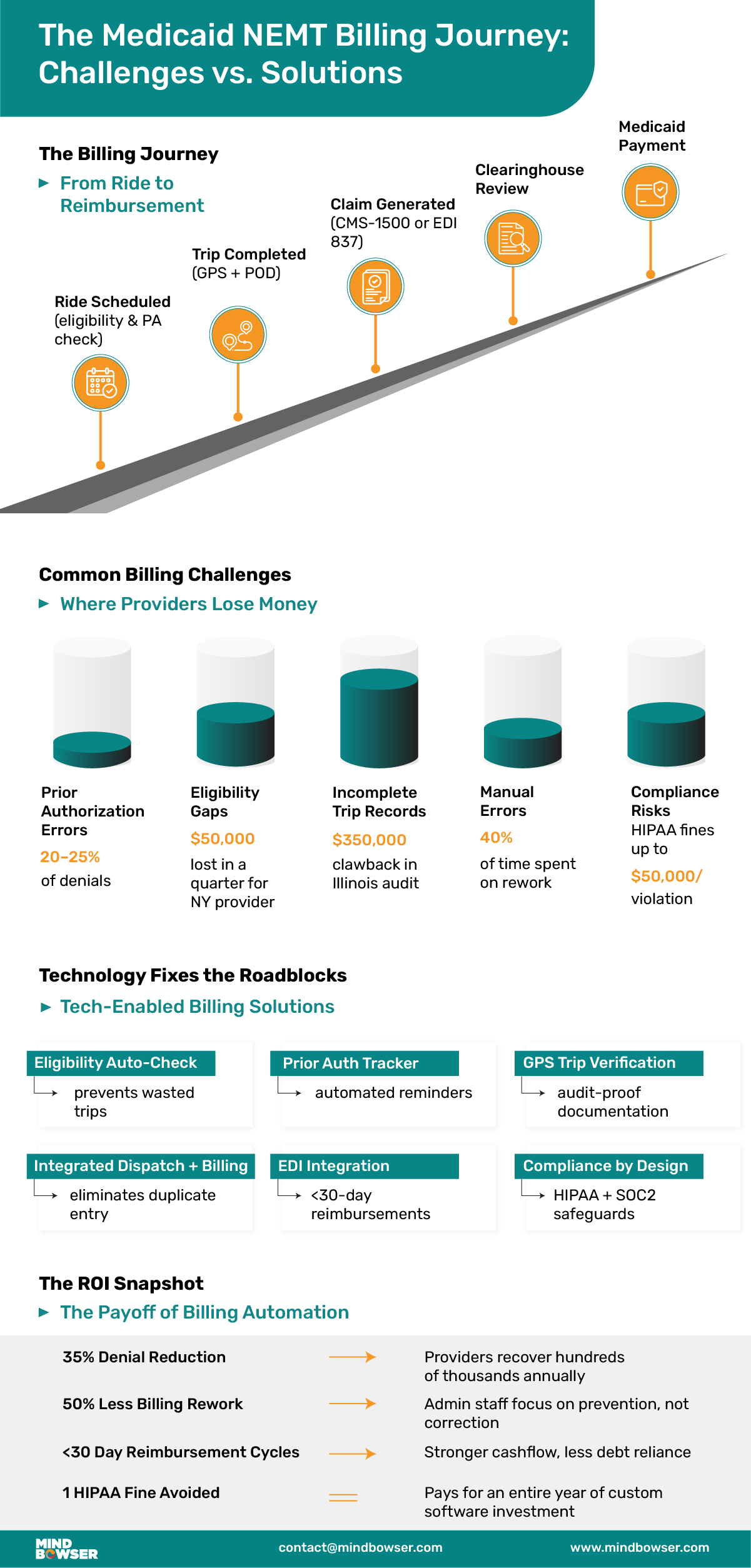Medicaid promises patients a ride to care, but for providers, those rides don’t always get paid. With 10–20% of NEMT claims being denied on first submission, operators face cash flow crunches, and patients face disruptions in care. Billing isn’t back-office housekeeping. It’s the financial engine of every transportation program. If it fails, the whole system feels the impact.
The Bottom Line
Medicaid billing isn’t just paperwork. It’s mission-critical. And until providers address the cracks in NEMT reimbursement, patients and operators alike will continue to pay the price.
At its simplest, Medicaid will only reimburse a trip if three boxes are checked:
What this means: even if a ride was necessary and completed, if the paperwork isn’t airtight, Medicaid won’t pay.
Here’s how a standard Medicaid NEMT claim flows from ride to reimbursement:
Bottom line: each step introduces opportunities for error. A single coding error, timestamp discrepancy, or authorization issue can compromise the entire claim.
Here’s where it gets thorny: Medicaid is federally funded, but each state runs its own program. That creates 50 different sets of rules.
Example: A provider serving both New York and Texas has to juggle two completely different systems. A process that works in one state may trigger denials in the other. For multi-state operators, complexity multiplies fast.
The Takeaway
Medicaid billing for NEMT is less a straight road and more a maze. Providers must prove necessity, secure authorization, and deliver comprehensive documentation—while also keeping up with the varying requirements of 50 state-level rules. No surprise that denial rates hover between 10% and 20%.
it’s a systemic challenge across NEMT. The good news? Modern technology can stop the leaks before they drain your business. See how Mindbowser helps providers recover revenue and rebuild trust.
If Medicaid billing were straightforward, providers wouldn’t lose thousands of dollars each month due to preventable denials. The reality is that billing workflows are fragile, highly regulated, and prone to errors at multiple touchpoints. Below are the most persistent challenges NEMT operators face.
Case in Point: A Midwest operator saw denial rates spike to 17% when a dialysis patient’s standing prior authorization expired mid-month. Without an automated tracker, dispatchers continued to schedule rides, unaware that the PA window had closed. Every one of those trips was later denied. Revenue was unrecoverable.
Bottom line: Without airtight authorization tracking, providers risk denials they cannot appeal.
Case Insight: A New York provider lost $50,000 in a single quarter when batch verification failed to flag 200 ineligible rides. Every claim was denied outright.
Bottom line: Eligibility must be verified in real time, not overnight.
Medicaid requires proof that the ride occurred exactly as billed. Missing even one detail can trigger denials or even fraud investigations.
Audit Example: In Illinois, a provider faced $350,000 in clawbacks when auditors found 1,200 trips lacked GPS-stamped proof of delivery. The rides happened, but without compliant documentation, Medicaid demanded repayment.
Bottom line: Documentation gaps turn completed rides into financial liabilities.
Billing teams still manually enter trip data, which creates endless opportunities for errors.
Bottom line: Manual data entry is too brittle for high-volume, compliance-heavy billing.
Every state enforces strict timelines for claim submission—often 90 or 180 days. If the deadline is missed, the claim is permanently non-payable.
Bottom line: Late submissions equal guaranteed revenue loss.
Billing systems must comply with HIPAA, CMS, and state regulations. Risks arise when:
Fines can reach $50,000 per violation. Repeat offenses can jeopardize a provider’s Medicaid contract.
Bottom line: Billing errors don’t just cost money. They can put the entire business relationship at risk.
Even legitimate claims are sometimes flagged as fraudulent if documentation trails are weak.
Real-World Insight: A behavioral health transport provider in Florida had 10% of claims frozen during a fraud investigation because logs lacked GPS validation. Rides were real, but missing proof caused months of delayed reimbursement.
Bottom line: Weak documentation creates unnecessary exposure to fraud audits.
Every denial is more than an inconvenience. It’s lost revenue, wasted staff time, and erosion of payer trust. Studies show that up to 40% of NEMT billing staff hours are spent reworking denied claims. The problem isn’t a a lack of effort—it’s outdated, manual processes that can’t keep pace with the complexity of Medicaid.
Billing errors in Medicaid NEMT don’t exist in a vacuum. They ripple across operations, finances, compliance, and even patient care. While individual denials may seem minor, their cumulative impact can destabilize entire transportation programs.
For most NEMT operators, Medicaid is the primary source of revenue. When 10–20% of claims are denied or delayed, cash flow becomes unpredictable.
Case Example: A 40-vehicle fleet in Texas reported that reimbursement delays forced them to use a $250,000 credit line just to cover fuel bills. The interest expense alone costs them $25,000 annually — money that could have been invested in expansion or compliance upgrades.
Not all denied claims can be salvaged. Many Medicaid denials — especially those tied to missed prior authorization or late submissions — are non-appealable.
Data Point: CMS estimates that 10–20% of Medicaid claims are denied on first submission. Even if half are recovered through resubmissions, the remaining losses are significant.
Behind every denial is a mountain of paperwork. Billing teams spend excessive hours on rework, slowing down other functions.
Scenario: A behavioral health transport service employing four full-time billing clerks discovered that three of them spent most of their week resolving denials. According to their own calculations, $120,000/year in labor costs was allocated to rework alone.
Billing errors don’t just cost money — they can trigger compliance investigations. Medicaid and CMS program integrity units actively monitor claims for irregularities.
Billing problems in Medicaid NEMT are not merely clerical errors; they are often indicative of more significant issues. They represent a systemic risk to financial stability, compliance integrity, and patient access to care. For providers operating on tight margins, even modest denial rates can mean the difference between growth and closure.
Audit Example: An Illinois operator was forced to repay $350,000 after a Medicaid audit found gaps in GPS trip verification. The rides had occurred, but without compliant proof, the payments were clawed back.
In Medicaid NEMT, trust is currency. Hospitals, brokers, and state agencies must believe that providers deliver reliable and compliant services. Billing errors undermine that trust.
Industry Insight: One regional fleet in the Midwest lost its contract with a major Medicaid broker after repeated claim delays flagged them as “high-risk.” Despite strong on-time performance, their billing inefficiency cost them the relationship — and millions in annual revenue
Manual billing and outdated systems leave providers vulnerable to denials, cash flow delays, and compliance risks. Purpose-built technology flips the equation. Instead of reacting to denials after they occur, providers can prevent errors upfront, streamline workflows, and protect revenue. Here’s how.
Case Example: A New York provider cut denial rates from 18 percent to under 5 percent within 90 days by implementing pre-trip eligibility verification.
Bottom line: Real-time eligibility checks prevent wasted trips and protect cash flow.
Scenario: A Midwest dialysis transport operator reduced PA-related denials by 70 percent after adopting automated reminders integrated with dispatch.
Bottom line: Automated PA management closes one of the largest gaps in Medicaid billing denial.
Audit Example: An Illinois provider avoided $200,000 in clawbacks after switching to GPS trip verification and digital signatures, satisfying state auditors with thorough and accurate records.
Bottom line: Verified trips mean fewer denials and stronger audit defense.
Efficiency Insight: One behavioral health transport provider cut billing administration time by half after moving from manual entry to an integrated platform.
Bottom line: Unified workflows eliminate the swivel-chair problem that drives denials.
Financial Impact: A regional operator reduced average DSO from 60 days to 28 days by adopting EDI 837/835 workflows.
Bottom line: Direct EDI integration streamlines payments and minimizes the risk of rejection.
Outcome: A Florida behavioral health provider avoided a fraud investigation when their system automatically produced verifiable logs for every trip billed.
Bottom line: Strong verification safeguards revenue while protecting reputation.
Regulatory Note: With HIPAA fines reaching $50,000 per violation, compliance built into the foundation is not optional—it’s a matter of survival.
Bottom line: Compliance baked into workflows ensures long-term security and payer trust.
Technology does more than reduce denials. It rewrites the billing equation entirely. By embedding eligibility checks, prior authorization tracking, trip verification, and compliance into daily workflows, providers shift from reactive firefighting to proactive revenue protection.
The result is straightforward:

Generic healthcare billing and transportation tools look tempting. Quick setup, lower sticker price, familiar screens. In Medicaid NEMT, that promise breaks under real rules, real volumes, and real audits. The result is higher denial rates, hidden costs, and blind spots providers cannot afford.
Bottom line: Templates that ignore state rules convert routine trips into avoidable denials.
Bottom line: If dispatch and billing do not share a source of truth, denial risk compounds at volume.
Bottom line: Without denial analytics, teams fight fires, not causes.
Bottom line: When you do not own the capability, you rent your future.
Bottom line: Compliance cannot be bolted on. It must be baked in.
Bottom line: If the software cannot adapt to state variations, expansion becomes a cost center, not a growth lever.
Not more tools. Better workflows. Off‑the‑shelf billing solves for averages, but Medicaid NEMT lives in specifics. Rules vary, auditors scrutinize, and cash flow depends on clean first-pass claims. If your system cannot integrate with dispatch, adapt to state policy, expose denial patterns, and meet HIPAA requirements by design, you will pay in denials, labor, and risk. Why gamble revenue on templates that were never built for your routes, your payers, your rules?
For years, many NEMT providers have relied on broker portals or generic billing platforms. That patchwork may work for a handful of trips in a single state. But when volumes scale, rules diverge, and audits intensify, the cracks become unsustainable. Custom billing software flips the script. Instead of forcing your operation to conform to rigid templates, it adapts to your contracts, workflows, and compliance environment.
Scenario: A multi-state Midwest provider reduced denials by 35 percent after deploying a custom rules-based engine integrated with state Medicaid APIs.
Bottom line: Custom rules engines turn state variability from a liability into a strength.
Efficiency gain: A behavioral health operator cut billing admin time by 50 percent after adopting a dispatch-to-billing integration built for their workflows.
Bottom line: Unified data capture means faster billing, fewer denials, less rework.
Leadership value: A 50-vehicle fleet built denial heatmaps into its dashboard. The tool revealed that one broker was responsible for 70 percent of the delays. They used the data to renegotiate terms, recovering $200,000 annually.
Bottom line: Custom reporting turns billing data into business intelligence.
Expansion example: A regional fleet expanded from Medicaid-only to a mixed payer model (Medicaid, Medicare Advantage, and commercial). Their custom platform handled the transition without adding a second billing tool.
Bottom line: Growth requires flexibility, not parallel workarounds.
Strategic control: One large operator avoided $300,000 per year in subscription fees by building a custom platform they owned outright.
Bottom line: Owning the system means owning your future.
Compliance win: A New York operator passed a Medicaid audit with zero findings after adopting custom billing software that tied every billed trip to GPS and electronic proof-of-delivery.
Bottom line: Compliance by design eliminates surprises and protects contracts.
Custom billing software is more than just a technical upgrade. It is a strategic asset. Providers that invest in tailored systems see measurable gains in:
Margins in NEMT are thin. Compliance risk is high. The difference between growth and closure often lies in whether billing is treated as generic admin or strategic infrastructure.
Custom billing systems for Medicaid NEMT aren’t theory. Providers across the U.S. are already using them to recover revenue, cut administrative costs, and pass compliance audits with confidence. The following cases highlight measurable results.
Bottom line: Custom billing stabilized cash flow and gave leadership confidence to expand into new counties.
Bottom line: Integrated systems converted a denial factory into a streamlined billing engine.
Bottom line: Faster reimbursement turned cashflow from a liability into a growth driver.
Bottom line: Compliance-ready documentation turned a near-miss into a long-term contract win.
Across these cases, three themes stand out:
Whether a provider runs 30 vehicles or 300, custom billing systems transform Medicaid NEMT from fragile and reactive to predictable and growth-ready.
Numbers often cut through complexity faster than narrative. Medicaid NEMT billing is riddled with inefficiencies, denials, and compliance risks that providers cannot afford to overlook. The following statistics highlight just how big the stakes are—and how much providers stand to gain by modernizing their systems.
What this means: Every tenth trip—or more—is at risk of going unpaid without intervention.
What this means: Providers are paying for labor that doesn’t advance the business—it just patches holes.
What this means: Faster cash flow directly reduces reliance on credit lines, often saving providers $20,000 to $50,000 annually in financing costs.
What this means: Compliance gaps don’t just create financial risk—they threaten the survival of the contract itself.
Outputs would estimate:
What this means: The return on billing automation often pays for itself within 9 to 12 months.
The data is clear:
Technology isn’t a luxury add-on. It is the only way providers can remain solvent, compliant, and competitive in the Medicaid NEMT market.
Solving Medicaid NEMT billing challenges is not about installing off-the-shelf software. It requires a structured approach that blends technology, compliance expertise, and a deep understanding of provider workflows. Over the past decade, Mindbowser has partnered with NEMT operators, brokers, and healthcare organizations to re-engineer billing operations, reduce denials, and accelerate reimbursements. Here is how the process works.
Consultant’s note: Providers often underestimate hidden rules such as rural mileage thresholds or trip bundling. Capturing these rules early prevents expensive rework later.
Bottom line: Discovery ensures that the solution is tailored to the provider’s environment, not a generic template.
This step enables stakeholders to preview the future system before its full rollout, fostering alignment and reducing resistance.
Bottom line: Prototyping builds confidence that the system will solve real-world problems before development begins.
Result: A behavioral health operator saw denial rates fall by 12 percent after the very first sprint—eligibility checks—was deployed.
Bottom line: Agile delivery means faster wins for providers while building a fully compliant, long-term solution.
Real-world example: When New York Medicaid rolled out a new prior authorization submission API, a provider on Mindbowser’s platform adapted in two weeks. Competitors relying on SaaS vendors waited nearly eight months for vendor updates.
Bottom line: Continuous support protects revenue long after deployment.
The consultant’s takeaway: Providers don’t need another generic billing tool. They need a partner who understands Medicaid’s complexity and designs technology that reduces denials, protects compliance, and scales with growth. That is the role Mindbowser plays.
Mindbowser’s process—discovery, prototype, agile build, and ongoing support—turns Medicaid billing from a fragile, manual process into a strategic asset. Providers using these systems consistently see:
In a market where margins are razor-thin and compliance risk is constant, the right partner makes billing predictable, defensible, and growth-ready.
Billing is the lifeline of NEMT operations. Vehicles, drivers, and dispatchers may keep the service running day to day, but without clean Medicaid claims, providers do not get paid. And when cash flow stalls, the impact spreads quickly to patients, hospitals, and payers alike.
Bottom line: Billing is not back-office clerical work. It is mission-critical infrastructure.
Bottom line: Errors cost money, time, reputation, and contracts.
Bottom line: Automation shifts providers from reactive denial-fighting to proactive revenue protection.
Bottom line: What looks inexpensive up front often creates higher costs in denials, staff hours, and risk.
Real-world outcomes:
Bottom line: Custom systems protect revenue, strengthen compliance, and support growth.

Medicaid billing is both the most fragile and the most important function in NEMT. Providers relying on manual processes or generic tools will continue to face denial cycles, compliance investigations, and unstable cash flow. Providers who modernize with custom-built software can ensure accuracy, accelerate payments, and maintain trust with payers.
This is not about fixing clerical errors. It is about reimagining billing as a strategic driver of financial stability and patient access to care. The providers who invest in custom, compliance-ready billing will not only survive Medicaid’s complexity. They will thrive in it.
The most common denial drivers include:
Executive insight: Most of these issues are preventable with automated eligibility checks, prior authorization tracking, and trip verification tools. Providers that automate these steps cut denial rates by more than half.
Executive insight: Track Days Sales Outstanding (DSO) as a core KPI. Anything consistently above 45 days signals process inefficiencies.
Yes, and it should. Integration is not a feature; it is a requirement.
Executive insight: When evaluating a platform, ask if dispatch data auto-populates into claims. If staff still re-enter information, denial risk remains high.
Fraud prevention depends on audit-ready data trails. Custom systems embed these protections into daily workflows.
Executive insight: Strong audit logs not only protect against fraud but also prevent legitimate claims from being frozen during investigations.
Yes. The ROI is clear and often fast.
Executive insight: Run a denial-prevention ROI model. Take your current denial percentage, apply it to monthly billing volume, and calculate potential revenue recovered if denials are cut in half. For most operators, the savings cover the system within a year.

We worked with Mindbowser on a design sprint, and their team did an awesome job. They really helped us shape the look and feel of our web app and gave us a clean, thoughtful design that our build team could...


The team at Mindbowser was highly professional, patient, and collaborative throughout our engagement. They struck the right balance between offering guidance and taking direction, which made the development process smooth. Although our project wasn’t related to healthcare, we clearly benefited...

Founder, Texas Ranch Security

Mindbowser played a crucial role in helping us bring everything together into a unified, cohesive product. Their commitment to industry-standard coding practices made an enormous difference, allowing developers to seamlessly transition in and out of the project without any confusion....

CEO, MarketsAI

I'm thrilled to be partnering with Mindbowser on our journey with TravelRite. The collaboration has been exceptional, and I’m truly grateful for the dedication and expertise the team has brought to the development process. Their commitment to our mission is...

Founder & CEO, TravelRite

The Mindbowser team's professionalism consistently impressed me. Their commitment to quality shone through in every aspect of the project. They truly went the extra mile, ensuring they understood our needs perfectly and were always willing to invest the time to...

CTO, New Day Therapeutics

I collaborated with Mindbowser for several years on a complex SaaS platform project. They took over a partially completed project and successfully transformed it into a fully functional and robust platform. Throughout the entire process, the quality of their work...

President, E.B. Carlson

Mindbowser and team are professional, talented and very responsive. They got us through a challenging situation with our IOT product successfully. They will be our go to dev team going forward.

Founder, Cascada

Amazing team to work with. Very responsive and very skilled in both front and backend engineering. Looking forward to our next project together.

Co-Founder, Emerge

The team is great to work with. Very professional, on task, and efficient.

Founder, PeriopMD

I can not express enough how pleased we are with the whole team. From the first call and meeting, they took our vision and ran with it. Communication was easy and everyone was flexible to our schedule. I’m excited to...

Founder, Seeke

We had very close go live timeline and Mindbowser team got us live a month before.

CEO, BuyNow WorldWide

Mindbowser brought in a team of skilled developers who were easy to work with and deeply committed to the project. If you're looking for reliable, high-quality development support, I’d absolutely recommend them.

Founder, Teach Reach

Mindbowser built both iOS and Android apps for Mindworks, that have stood the test of time. 5 years later they still function quite beautifully. Their team always met their objectives and I'm very happy with the end result. Thank you!

Founder, Mindworks

Mindbowser has delivered a much better quality product than our previous tech vendors. Our product is stable and passed Well Architected Framework Review from AWS.

CEO, PurpleAnt

I am happy to share that we got USD 10k in cloud credits courtesy of our friends at Mindbowser. Thank you Pravin and Ayush, this means a lot to us.

CTO, Shortlist

Mindbowser is one of the reasons that our app is successful. These guys have been a great team.

Founder & CEO, MangoMirror

Kudos for all your hard work and diligence on the Telehealth platform project. You made it possible.

CEO, ThriveHealth

Mindbowser helped us build an awesome iOS app to bring balance to people’s lives.

CEO, SMILINGMIND

They were a very responsive team! Extremely easy to communicate and work with!

Founder & CEO, TotTech

We’ve had very little-to-no hiccups at all—it’s been a really pleasurable experience.

Co-Founder, TEAM8s

Mindbowser was very helpful with explaining the development process and started quickly on the project.

Executive Director of Product Development, Innovation Lab

The greatest benefit we got from Mindbowser is the expertise. Their team has developed apps in all different industries with all types of social proofs.

Co-Founder, Vesica

Mindbowser is professional, efficient and thorough.

Consultant, XPRIZE

Very committed, they create beautiful apps and are very benevolent. They have brilliant Ideas.

Founder, S.T.A.R.S of Wellness

Mindbowser was great; they listened to us a lot and helped us hone in on the actual idea of the app. They had put together fantastic wireframes for us.

Co-Founder, Flat Earth

Mindbowser was incredibly responsive and understood exactly what I needed. They matched me with the perfect team member who not only grasped my vision but executed it flawlessly. The entire experience felt collaborative, efficient, and truly aligned with my goals.

Founder, Child Life On Call

The team from Mindbowser stayed on task, asked the right questions, and completed the required tasks in a timely fashion! Strong work team!

CEO, SDOH2Health LLC

Mindbowser was easy to work with and hit the ground running, immediately feeling like part of our team.

CEO, Stealth Startup

Mindbowser was an excellent partner in developing my fitness app. They were patient, attentive, & understood my business needs. The end product exceeded my expectations. Thrilled to share it globally.

Owner, Phalanx

Mindbowser's expertise in tech, process & mobile development made them our choice for our app. The team was dedicated to the process & delivered high-quality features on time. They also gave valuable industry advice. Highly recommend them for app development...

Co-Founder, Fox&Fork
